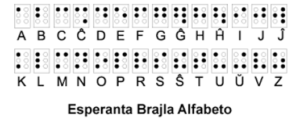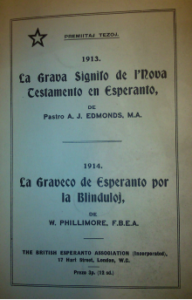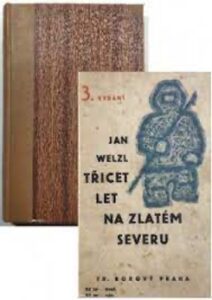‘I kindled a fire in my heart’ – A blind Esperanto wanderer, Japanese anarchists, and a Moravian Eskimo chief
He was born in 1890, in the western borderlands of Tsarist Russia. This was an unlikely place from what turned out to be a truly global life that would later take him to England, to Germany, to Finland, to India, Siam and other destinations in Asia and Europe between 1912 and the 1940s. As a young man in London, he had encounters with Russian intellectuals and anarchists. His network and his language skills would take him to Japan a little later before founding a school for blind children in Kushka, in Turkmenistan. All this (and much more) seems even more unlikely if we imagine that as a young boy, he contracted measles and was disabled.
Measles always affects the eyes one way or another. One does not necessarily turn blind but even today an estimated 100,000 children lose their eyesight each year from the disease. Vasilij Eroschenko, a boy from Ukraine who contracted measles, was unlucky. Measles blinded him by the age of four. Yet looking back at his life we must imagine a hopeful, energetic, if not stubborn young Vasilij. In 1952, Eroschenko died in the Soviet Union aged 62. Today, a small provincial museum in Obukhovka, Russia, not too far off the border to Ukraine, commemorates his life and travels. During his lifetime, his writings were published in Russian, Japanese and Esperanto.
Perhaps Eroschenko was not (so) unlucky. A few years before the young boy lost his eyesight, an eye doctor based in Warsaw by the name of Ludwik L. Zamenhof had invented the universal or international language Esperanto. While Zamenhof’s medical expertise could not save Eroschenko’s eyesight, Esperanto did set him up for a rather extraordinary life. Following Esperanto’s first publications of manuals and learning material in 1887 and 1888, the language started taking root across Europe and soon elsewhere in the US, China and Japan. And the first international Esperanto congress was held in Boulogne-sur-Mer in France in 1905.
Zamenhof had devoted his time, energy, as well as a good part of his wife’s fortune to publish Esperanto material, to propagate the language, and to develop a social and cultural community around the new language. To Zamenhof Esperanto was meant to be an easy-to-use language to enable ‘neutral’ communication across many barriers and borders. The idea for the universal language had its own particular roots and context in Warsaw and in Tsarist Russia, first of all in Zamenhof’s Jewish background. The conflictual if not outright violent ethnolinguistic and religious tensions in Russia also played a major role for Zamenhof and his international language project. Once Esperanto took its place in the world, people did (and still do) different things with it. It did not take long until blind people took to the language and some of them turned up at the international congresses. Vasilij Eroschenko did so in Helsinki, Nürnberg, and later in Vienna during the 1920s and early 1930s.
One of the first pioneers to promote Esperanto for the blind was Théophile Cart (1855-1931). The French linguist and teacher came to Esperanto as early as 1894, and he was a leading figure in the Esperanto movement. To Cart and several fellow Esperantists, the still new language had the potential to lift the blind out of their often isolated lives. In 1904, Cart founded Esperanta Ligilo, a monthly journal published in Paris. It was printed in the tactile braille writing system adopted for the Esperanto alphabet.

In the very early years of the 20th century Esperanto took off. Big time. Looking back, it is a misconception that Esperanto was a failure. Esperanto clubs sprung up across Europe and beyond Europe. Journals were launched and Esperanto – with the first congress not far away in 1905 – was literally in the news. And news travelled fast in those years of mass media and new technology around 1900, for instance to Sweden.
Harald Josias Thilander (1877-1958) was born in Breared, south of Gothenburg. Thilander lost his eyesight as a young adolescent in 1890. By 1900 we find him in the Adresario, the address books of Esperantists that Zamenhof published annually. In 1907, Thilander visited the third international congress in Cambridge and over the next few years he became an ardent publisher of Esperanto-related material dedicating his time and energy to advance the language for the use and support of the blind. By 1912 he became the main editor of Esperanta Ligilo. In the early interwar years, Thilander was one of the co-founders of the Universala Asocio de Blindaj Esperantistoj (Universal Association for Blind Esperantists). The legacy of the first blind associations and the Ligilo lives on until today in the Ligo Internacia de Blindaj Esperantistoj.
In England, William Phillimore (1844-1934) who had come to study Esperanto around 1905 started learning the braille system and translated many literary works for the blind in Esperanto braille. In 1914 he published La Graveco de Esperanto por la Blindoj (The Importance of Esperanto for the Blind). Like Cart, he stressed the importance of Esperanto and the opportunities it offered for the blind and how the language could help to lift them out of their lives as disabled people. And he did deliver. Among the works translated into Esperanto braille by Phillimore was Tridek Jarojn en Ora Nordo (Thirty Years in the Golden North) in 1931. The book, originally published in Czech as Třicet let na zlatém severu, recounts the adventures of Jan Welzl (1868-1948) the Moravian traveller, hunter, gold digger, and later Eskimo chief (hence Eskymo Welzl as his pseudonym). It was a literary sensation in the Czech lands and beyond at the time. Thanks to the work and enthusiasm of Phillimore, Esperanto and braille, the blind could armchair travel as far as the North Pole9


It is hard to imagine young Vasilij Eroschenko’s life taking a global turn without these early initiatives to promote Esperanto for the blind. Blind or not, his disability did not deter him. On the contrary, it may have “fired” him up. When Eroschenko later turned to poetry in Esperanto he penned the following lines:
Ekbruligis mi fajron en kor’,
Ĝin estingos nenia perfort’;
Ekflamigis mi flamon en brust’,
Ĝin ne povos estingi eĉ mort’.
I kindled a fire in my heart’,
It will not be extinguished by violence’;
I kindled a flame in my chest’,
It cannot be extinguished even by death’.
Eroschenko was an ardent student and a lover of both music and languages. His eagerness for learning frequently provoked trouble with his teachers as we learn from his autobiographical writings including Lumo kaj Ombro (Light and Shadow). From 1907 until 1914, Eroschenko was in Moscow employed as a violinist at the Moscow Orchestra for the Blind. It was around 1910 when an acquaintance suggested he should do three things: continue his English language studies, learn Esperanto, and go to England to study music. Two years later, taking leave from his Moscow position, Eroschenko did indeed turn up in London where the Royal Normal College for the Blind accepted him as a student.
The traces left behind from his time in England in journals and newspapers suggest that by then the Esperanto network and community was well-oiled as a number of local Esperantists helped him settle into his new life and environment. In London, Eroschenko met another Russian, Pyotr Kropotkin (1842-1921), and mixed with other Russian exiles who had left the Tsarist Regime behind. Whatever set his life in motion after his visit in England, it was most certainly driven by radical ideas, the support of the widespread Esperanto community, and Eroschenko’s knack for languages. By 1912 he had at least four to take him around the world: his native Russian, English, Japanese, and Esperanto.
When Eroschenko returned to Moscow in 1914 the Rusa Esperanto-Federacio (Russian Esperanto Federation) sent him to Japan. Esperanto had taken early roots in Japan, particularly among intellectuals, writers and radicals. Eroschenko taught Esperanto to groups of blind people and enrolled for further education hoping to become a doctor. While the First World War raged, Eroschenko continued teaching Esperanto, briefly travelling to Siam, then Burma, and from there to Calcutta in 1919. Even though he had always distanced himself from political agitation, anarchism and radicalism, the British authorities in India did not trust this blind Esperanto poet and wanderer who had come from what was now revolutionary Russia. He was evicted and returned to Russia via Afghanistan. That was by no means the end of his travels. (Note: I know you may wish to read on, but can we just close our eyes for a moment, reflect and imagine this journey – far from over – between 1912 and 1919.)
In 1919 Eroschenko, now 29 years of age, returned to Japan. He taught Esperanto, toured, and lectured on Russian and Japanese culture and language. Japanese Esperantists looked after him but by then his Japanese was good enough to publish works including children’s books. The latter was supported by Ichiko Kamichika (1888-1981) a parliamentarian, feminist, journalist, writer, and translator. Suspicious of political agitation in Japan, Eroschenko was arrested shortly thereafter and expelled in 1921. He arrived in Vladivostok, yet in the tumultuous years of the Russian Revolution and the ongoing civil war, anti-communist authorities were soon after him. Disguised in a Chinese worker’s outfit, Eroschenko managed to make his way to China. He taught Esperanto and Russian literature at several institutions including Beijing University.
Eroschenko did not just walk into any of these institutions asking for work. That is not how it worked. Once again, the wide-cast network of Esperantists came to help and support. In China it was the support and interest in his work by Zhou Zuoren (1885-1967) and his brother Lu Xun (1881-1936) both writers, intellectuals, and actively involved in the Fourth of May anti-imperialist movement in 1919. The two brothers not only housed Eroschenko, but they also started translating his work that had previously been published in Esperanto and Japanese making it available for a Chinese audience. From China Eroschenko travelled to the Esperanto World Congress in Helsinki in 1922 – and back. In 1923 he left China and visited another World Congress in Nürnberg before returning to the Soviet Union in 1924 where he directed a nursery for blind children.

Further journeys followed. For instance, he went to northern Siberia in the late 1920s. In all these years back in Russia, Eroschenko’s Esperanto contacts and networks in China, Japan, and Britain continued to flourish. Slowly but steadily his works, poems, shorter novels were published in Chinese, and by 1934 his entire work had been published in Japanese. Eroschenko kept on publishing in Esperanto and several of his articles were printed in Britain in Esperanto braille.
There was one last journey and perhaps another twist of luck. In 1935 Vasilij Eroschenko left for Turkmenistan, a Soviet Socialist Republic then, where he taught for a while. We cannot be sure but during a time when the Stalinist regime persecuted Esperantists, Turkmenistan may have been a safe place to be. We cannot be sure. Had Eroschenko not been disabled and blind, we do not know what twists and circumstances his life may have taken. Had Esperanto not existed and had others like Phillimore, Cart, Thilander and other Esperantists not pushed to make Esperanto accessible to the blind, he may not have led the live he led. Many Esperantists past and present confirm that Esperanto makes you see the world through different eyes. Personally, I do agree. Vasilij Eroschenko did not see London, Moscow, Burma, Calcutta, Japan with his own eyes. But – what a life and journey it was.
The St Andrews University Library holds a number of Eroschenko’s works in Esperanto including Lumo Kaj Ombro(Light and Shadow) and Malvasta Kago (A Narrow Cage).
Primary Sources
Cart, Théophile, A. J. Adams, and John Beveridge. Esperanto and the Blind. Paris: Centra Presejo Esperantista V. Polgar 33, rue Lacépède, 1910.
Cart, Théophile, and John Beveridge. Esperanto Kaj La Blinduloj Jarlibro Por 1910 (Adresaro de La Abonantoj de Esperanta Ligilo). Paris: Presa Esperantista Societo 33, Rue Lacépède, 33, 1910.
Eroshenko, Vasilii, and Mine Yositaka. Lumo Kaj Ombro. Tokyo: Japana Esperanta Librokooperativo, 1979.
Wilson, Henry J. ‘The International Conference on the Blind*’. Journal of Visual Impairment & Blindness 8, no. 2 (1 June 1914): 65–70. https://doi.org/10.1177/0145482X1400800204.
Secondary Sources
Garvia, Roberto. Esperanto and Its Rivals. The Struggle for an International Language. University of Pennsylvania Press, 2015.
Historia de la Esperanto-movado inter la blinduloj 1888-2015. Ligo Internacia de Blindaj Esperantistoj (LIBE), Keuruskopio, 2016.
Jones, Andrew F. Developmental Fairy Tales: Evolutionary Thinking and Modern Chinese Culture. Cambridge, Mass: Harvard University Press, 2011.
Konishi, Sho. Anarchist Modernity: Cooperatism and Japanese-Russian Intellectual Relations in Modern Japan. Cambridge, Massachusetts: Harvard University Press, 2013.
Lins, Ulrich. Dangerous Language — Esperanto and the Decline of Stalinism. Springer, 2017.
Müller-Saini, Gotelind, and Gregor Benton. ‘Esperanto and Chinese Anarchism in the 1920s and 1930s’. Language Problems and Language Planning 30, no. 2 (1 January 2006): 173–92. https://doi.org/10.1075/lplp.30.2.06mul.
O’Keeffe, Brigid. Esperanto and Languages of Internationalism in Revolutionary Russia. London New York: Bloomsbury Academic, 2021.
Seitz, Clemens J. Die Bienen und das Unsichtbare, Frankfurt am Main: Suhrkamp, 2020.
Sutton, Geoffrey. ‘Eroŝenko, Vasilij Jakovleviĉ’ in: Concise Encyclopedia of the Original Literature of Esperanto 1887–2007. New York: Mondial, 2008, 107–113
Xu, Xiaoqun. ‘Cosmopolitanism, Nationalism, and Transnational Networks: The “Chenbao Fujuan”, 1921—1928’. China Review 4, no. 1 (2004): 145–73.
Other
Museum Vasilij Erosenko
http://museums.eu/museum/details/13262/vasily-eroshenko-memorial-museum-of-literature
